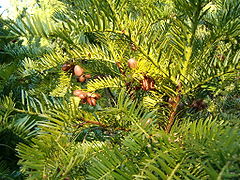Cephalotaxus harringtonii
| Cephalotaxus harringtonii | |
|---|---|
 |
|
| Close-up of a specimen in the Botanical Garden in Berlin | |
| Scientific classification | |
| Kingdom: | Plantae |
| Division: | Pinophyta |
| Class: | Pinopsida |
| Order: | Pinales |
| Family: | Cephalotaxaceae |
| Genus: | Cephalotaxus |
| Species: | C. harringtonii |
| Binomial name | |
|
Cephalotaxus harringtonii (Forbes) K. Koch |
|
Cephalotaxus harringtonii, commonly known as Korean plum yew,Japanese plum-yew,Harrington's cephalotaxus, or cowtail pine, is a coniferous bush or small tree in the plum yew family. It is native to Japan, but is occasionally utilised in western gardens and several cultivars exist for these purposes. Japanese plum yew has been in cultivation in Europe since 1829, and many modern horticulturists are familiar with this Japanese species, named in honor of the Earl of Harrington, one of the first to grow the plant in a European garden.
New shoots of C. harringtonii remain green for three years after forming and have ribs at the leaf bases. The buds are green in colour, globular in shape and very small at only 1 mm in length. There is one rank of leaves present on either side of the shoot, and these rise up above it and curve slightly inwards, forming a narrow V-shape somewhat akin to a dove's wings. The ranks are often vertical, but can be more flattened in shaded parts. The leaves are broadly linear in shape and measure about 5 cm long by 0.3 cm wide. They are abruptly pointed at the apex, leathery in texture and a bright matte yellowish-green on the upper-surface. The abaxial surface, or underside of the leaves, shows two broad, pale to silvery stomatal bands.
The species is dioecious and the male plants are typically densely covered with pairs of flowers that are pale cream in colour, though they become brown with time, and globular in shape. They are borne on 2 to 4 mm stalks beneath each pair of leaves. Pollen is released from March until May. The female individuals have two pairs of knob-like globose flowers that appear on curved stalks at the bases of the shoots. The fruit is obovoid in shape and measures 2.5 cm long by 1.5 cm wide. They are a smooth and pale green ín colour with dark green stipes, though when ripe they turn brown.
The Japanese plum yew was first considered to be a yew when it was partially described by Thomas Andrew Knight in 1839 and as such was named Taxus harringtonii. It was reclassified by Philipp Franz von Siebold and Joseph Gerhard Zuccarini in 1846 with a new specific name, Cephalotaxus drupacea. Some botanists consider C. koreana and C. sinensis to be synonymous with C. harringtonii. Although normally found under the name Cephalotaxus harringtonia, that name violates the grammar rules of Botanical Latin and in 2012 was corrected to Cephalotaxus harringtonii. However, this opinion is still not universally accepted by taxonomists and therefore it is acceptable to use Cephalotaxus harringtonia until a definitive position has been agreed.
...
Wikipedia

